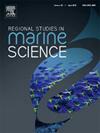Ecological risk assessment of organochlorine pesticides in coastal sediments: A multi-level approach in the greater bay area
IF 2.1
4区 环境科学与生态学
Q3 ECOLOGY
引用次数: 0
Abstract
The ecological risks posed by persistent organic pollutants are currently a hot research topic in the Guangdong-Hong Kong-Macao Greater Bay Area (GBA). As one of the four largest bay areas globally, and the most economic dynamic region in China, the GBA faces significant environmental challenges, particularly concerning pesticide contamination in coastal sediments. However, studies on the ecological risks of organochlorine pesticides(OCPs) in GBA's coastal sediments remain limited, leading to an insufficient scientific basis for risk management. This study investigate the distribution characteristics of OCPs in coastal sediments in GBA and evaluates their ecological risks employing a multi-level risk assessment approach. The results show that eight OCPs are widely present in GBA's coastal sediments, with concentrations ranging from 0.013 ng/g to 139.56 ng/g. Based on the Risk Quotient (RQ) method, the descending order of ecological risk for these OCPs is as follows: endosulfan, dichlorodiphenyltrichloroethane (DDTs), chlordane, β-hexachlorocyclohexane (HCH), α-HCH, γ-HCH, Hexachlorobenzene (HCB), and mirex. Among them, endosulfan has a high environmental risk, while γ-HCH and DDT present medium environmental risk. Chlordane, β-HCH, and α-HCH exhibit low environmental risk. The semi-probability method evaluation showed that the frequency of endosulfan exceeding predicted no-effect concentration (PNEC) was 91.6 %; while γ-HCH and DDTs had exceedance probability of of 69.4 % and 66.6 %, respectively. The optimized semi-probability method ranked the priority indices of endosulfan, γ-HCH, DDTs, chlordane and β-HCH at 8882.3, 87.2, 77.6, 15.3 and 1.9, respectively. Based on these findings, particular attention should be given to the ecological risks of endosulfan and DDTs in GBA's coastal sediments. This study provides a comprehensive scientific basis for understanding the current status and sources of OCP pollution in the GBA. Moreover, it offers critical insights into the potential ecological risks associated with these contaminants, serving as a scientific foundation for formulating targeted pollution control strategies and environmental management policies.
大湾区沿海沉积物中有机氯农药的生态风险评价
持久性有机污染物带来的生态风险是当前粤港澳大湾区研究的热点问题。作为全球四大湾区之一和中国经济最具活力的地区,大湾区面临着重大的环境挑战,特别是沿海沉积物中的农药污染问题。然而,对大湾区沿海沉积物中有机氯农药生态风险的研究仍然有限,导致风险管理的科学依据不足。本研究探讨了大湾区海岸带沉积物中ocp的分布特征,并采用多层次风险评价方法对其生态风险进行了评价。结果表明,8种OCPs在大湾区海岸沉积物中广泛存在,浓度范围为0.013 ng/g ~ 139.56 ng/g。基于风险商(RQ)法,这些有机污染物的生态风险由大到小依次为硫丹、二氯二苯三氯乙烷、氯丹、β-六氯环己烷、α-HCH、γ-HCH、六氯苯、灭螨。其中,硫丹具有高环境风险,γ-六氯环己烷和滴滴涕具有中等环境风险。氯丹、β-六氯环己烷和α-六氯环己烷的环境风险较低。半概率法评价表明,硫丹超过预测无效应浓度(PNEC)的频率为91.6 %;γ-HCH和DDTs的超标概率分别为69.4% %和66.6% %。优化后的半概率法对硫丹、γ-HCH、DDTs、氯丹和β-HCH的优先指数分别为8882.3、87.2、77.6、15.3和1.9。基于这些发现,大湾区沿岸沉积物中硫丹和DDTs的生态风险应引起特别关注。本研究为了解大湾区OCP污染现状及来源提供了全面的科学依据。此外,它还提供了与这些污染物相关的潜在生态风险的重要见解,为制定有针对性的污染控制战略和环境管理政策提供了科学基础。
本文章由计算机程序翻译,如有差异,请以英文原文为准。
求助全文
约1分钟内获得全文
求助全文
来源期刊

Regional Studies in Marine Science
Agricultural and Biological Sciences-Ecology, Evolution, Behavior and Systematics
CiteScore
3.90
自引率
4.80%
发文量
336
审稿时长
69 days
期刊介绍:
REGIONAL STUDIES IN MARINE SCIENCE will publish scientifically sound papers on regional aspects of maritime and marine resources in estuaries, coastal zones, continental shelf, the seas and oceans.
 求助内容:
求助内容: 应助结果提醒方式:
应助结果提醒方式:


